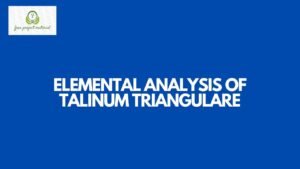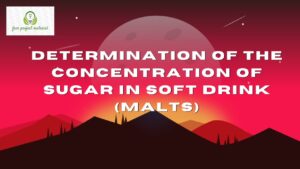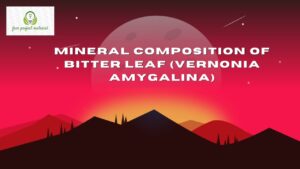ABSTRACT
The study was design to determine the comparative proximate composition of raw, boiled and roasted unripe Musa paradisiaca (plantain) pulp. The study was carried out using standard analytical method. The result of the study revealed that the ash, total carbohydrate and caloric value were significantly higher (P<0.05) in roasted than the boiled and raw plantain, crude fibre and moisture content were significantly higher in boiled plantain when compared to the raw and roasted plantain. Therefore, either of the two methods can be adopted while processing unripe plantain depending on the requirement by an individual at a particular time. Thus, it is recommended that Unripe plantain could be used to boost the nutrient and energy requirement in food supplements since it contains an appreciable amount of nutrients.
TABLE OF CONTENTS
Title Page – – – – – – – – – – i
Certification – – – – – – – – – ii
Dedication – – – – – – – – – – iii
Acknowledgment – – – – – – – – – iv
Abstract – – – – – – – – – – vi
Table of Contents – – – – – – – – vii
CHAPTER ONE: INTRODUCTION
1.1 Background of the study – – – – – – 1
1.2 Aim of the study – – – – – – – 2
1.3 Objectives of the study – – – – – – 2
1.4 Scope and limitation of the study – – – – – 3
1.5 Definition of terms – – – – – – – 4
CHAPTER TWO: LITERATURE REVIEW
2.1 Description of Plantain (Musa Paradisaca) – – – 5
2.2 Taxonomic Classification of plantain – – – – 7
2.3 Occurrence and Distribution of plantain – – – 8
2.4 Phytochemistry of plantain – – – – – – 9
2.4.1 Analgesic Activity – – – – – – – 9
2.4.2 Antidepressant Activity – – – – – – 10
2.4.3 Antidiarrhoel Activity – – – – – – 11
2.4.4 Antimicrobial Activity – – – – – – 12
2.4.5 Antidiabetic Activity – – – – – 14
2.5 Food processing – – – – – – – – 16
2.6 Types of Food Processing method – – – – – 17
2.7 Food Processing and Nutritional value of food – – – 19
2.8 Proximate Composition – – – – – – – 20
2.8.1 Moisture content – – – – – – – – 21
2.8.2 Ash content – – – – – – – – 22
2.8.3 Crude fibre – – – – – – – – 24
2.8.4 Crude fat – – – – – – – – 25
2.8.5 Crude protein – – – – – – – – 26
2.8.6 Total Carbohydrate – – – – – – – 27
2.8.7 Caloric value – – – – – – – – 27
CHAPTER THREE: MATERIALS AND METHODS
3.1 Materials and Reagents – – – – – – – 28
3.2 Methods – – – – – – – – – 28
3.2.1 Sample collection – – – – – – – 28
3.2.2 Sample preparation – – – – – – – 28
3.3 Determination of proximate composition – – – – 29
3.3.1 Determination of the moisture content of raw,
boiled & roasted plantain pulp – – – – – 29
3.3.2 Determination of the Ash content of raw,
boiled & roasted plantain pulp – – – – – 30
3.3.3 Determination of the crude fibre of raw,
boiled & roasted plantain – – – – – – 31
3.3.4 Determination of the crude protein of raw,
boiled & roasted plantain pulp – – – – – 33
3.3.5 Determination of the crude fat of raw,
boiled & roasted plantain pulp – – – – – 35
3.3.6 Determination of the total carbohydrates of raw,
boiled & roasted plantain pulp – – – – – 37
3.3.7 Determination of the caloric value of raw,
boiled & roasted plantain pulp – – – – – 37
3.4 Statistical Analysis – – – – – – – 38
CHAPTER FOUR: RESULTS AND DISCUSSION
4.1 Results – – – – – – – – – 39
4.2 Discussion – – – – – – – – – 40
CHAPTER FIVE: CONCLUSION AND RECOMMENDATION
5.1 Conclusion – – – – – – – – – 45
5.2 Recommendation – – – – – – – – 45
References
CHAPTER ONE: INTRODUCTION
1.1 Background of the Study
Plantain and cooking banana belong to the family Musaceae and the genus Musa, tree like perennial, 2-9 inch tall with an underground rhizome (Makanjuola et al., 2013). The origin of cultivated plantain and banana is from two wild diploid species; Musa acuminata and Musa balbisiana which have the genome as AA and BB respectively. Raw green plantain can only be eaten after cooking. Each fruit measures about 3 to 10 inches or more in length depending upon the cultivar type. They tend to have courses external features with prominent edges and flat surface. Plantain is a major starchy staples in the sub-saharan Africa both for rural and urban populace providing more than 25% of the carbohydrate and 10% of the daily caloric in-take for more than 70 million people in the continent (Kayoed, et al., 2013). Over 2.11 million metric tons of plantains are produced in Nigeria annually which contributes substantially to the nutritional value of subtropical local population (Akinsanmi, 2015). The plant is a source of food, beverages, fermentable sugars, medicines, flavouring, cooked foods, silage, fragrance, rope, cordage, garlands, shelter, clothing, smoking materials and numerous ceremonial and religious uses (Nelson et al., 2006). Plantain flowers, ripe fruit, unripe fruit, leaves and stem extract and its active constituents (Auta and Kumurga, 2015). The main pharmacological effects of this plants are: hepatoprotective, diuretic, analgesic, anti-ulcer, wound healing, hair-growth promoter and haemostatic activity (Kumar et al., 2012). Plantain Pulp is normally processed using the different processing methods. Lately, the consumption of roasted plantain pulps have been observed to increase tremendously across the country. Therefore, it becomes imperative to assess the proximate composition (Nutritional Value) of raw, boiled and roasted plantain comparatively.
1.2 Aim of the study
The aim of this study is to carryout the proximate composition of raw, boiled and roasted unripe plantain pulp.
1.2.1 Objectives of the study
The objectives of this study include:
- Determination of the Moisture content of raw, boiled and roasted plantain pulp
- Determination of the Ash content of raw, boiled and roasted plantain pulp
- Determination of the Crude fibre content of raw, boiled and roasted plantain pulp
- Determination of the Crude fat content of raw, boiled and roasted plantain pulp
- Determination of the total Carbohydrates content of raw, boiled and roasted plantain pulp
- Determination of the caloric value content of raw, boiled and roasted plantain pulp
1.3 Scope and Limitation of the Study
This study was designed to evaluate the Moisture, Ash, Crude Fibre, Crude fat, Total Carbohydrate and Caloric value of Musa paradisiaca Linn pulp, other parameters were not considered during the analysis due to lack of necessary equipment and financial constraint.
1.4 Definition of Terms
Proximate Analysis: is used for estimation of the quantitative of food and food substance including moisture, crude protein, total fat.
Composition: is the qualitive and quantitative makeup of a chemical compound.
Comparative: is a synaptic construction that serves to express a comparison between two or more groups of entities in quality or degree.
Nutritional Value: Nutritional value or nutritive value as part of food quality is the measure of a well-balanced ratio of the essential nutrients carbohydrates, fat, protein, minerals, and vitamins in items of food or diet concerning the nutrient requirements of their consumer.


